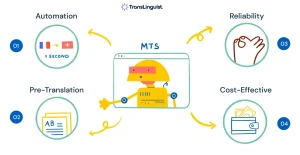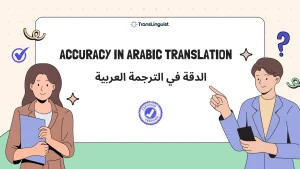Artificial Intelligence (AI) is shaking up almost every corner of our digital world, and the translation trade has felt the tremor as well. Smart algorithms, machine-learning brains, and advanced language tools are pushing the craft beyond its former near-exclusive reliance on human linguists, making translations faster, simpler, and surprisingly reliable. This evolution highlights the growing impact of AI on the translation business, driving efficiency and innovation across the industry.
At TransLinguist, we view these innovations as partners, not rivals, and use them to give our public and private clients steadier quality, quicker turnaround, and uniform style across all documents.
Speedy Turnaround
The clearest advantage is sheer speed. AI translation tools like Google Translate or DeepL scan and render thousands of words in mere seconds. Although a human touch is still essential, that rough draft lets teams push ahead much sooner, crucial for big batches such as policy papers, handbooks, or a whole European site.
Higher Accuracy through Neural Models
Neural machine translation, a mainstay of modern AI, sharpens syntax, grammar, and context grasp. Unlike earlier systems built on rules or on statistics, NMT never stops learning and adapting. Because it studies millions of actual translations, the model copes with idioms, slang, and tangled sentences that once baffled computers.
Smarter Translation Management Systems
Today’s cloud-based Translation Management Systems, which hold Translation Memories and term lists, now pair these features with AI. The result is faster, cheaper, and steadier work, perfect for firms that publish exacting or repetitive material.
Tighter Quality Control
AI-driven quality checks spot formatting slips, stray errors, and missing text without waiting for a linguist. By flagging trouble early, the tools lift the reviewers’ load and speed up multilingual projects.
Live Multilingual Talk
AI captioning and video remote interpretation link speakers across languages in real time, turning meetings into smooth, inclusive conversations.
AI Combined Human
It is a fact that AI speeds up the work and also saves a lot of cost, but it cannot predict culture, emotions, and is not 100% accurate. That is when a human linguist comes in handy. At TransLinguist, we put a certified linguist in the loop every time, so the machine helps but never speaks for the person.
Client Cost Optimization
By handling routine drudge work and reusing earlier translations through translation memories, AI trims the overall price of sending messages into many languages. That makes our service a smart choice for governments and nonprofits that need pocket-friendly language help without a quality compromise.
Concluding remarks
AI isn’t stealing translators’ jobs; it’s giving them better tools to shine. At TransLinguis, we believe the future belongs to teams where clever technology pushes human skill forward. By weaving AI into our process, we keep our translations accurate, culturally alive, client-centered, and delivered sooner and on a larger scale.
Want first-class translation backed by friendly machines and watchful experts? Reach out to TransLinguist today.
FAQs
How to use artificial intelligence in translation?
There are various ways to incorporate AI into translation workflows, like: Translation by Machine (MT), Post-Editing, Speech-to-Text Translation, Chatbots, Terminology Management
What is the impact of artificial intelligence on the translation industry?
By significantly boosting speed, scalability, and affordability, artificial intelligence (AI) has revolutionised the translation sector. Businesses can now translate content in real time across dozens of languages with tools like neural machine translation (NMT).
How does artificial intelligence influence?
AI has an impact on translation by:
- Quickening turnaround times for massive amounts of content
- cutting expenses in comparison to services that rely solely on manual labour
- Increasing the coherence of technical or repetitive content
- Facilitating instantaneous communication (e.g., virtual meetings, live subtitles)
What is the AI translator for business?
A technologically advanced tool called an AI translator for business allows organisations to: automatically translate emails, chats, documents, and websites, provide multilingual captioning or interpretation for in-person meetings, content localisation for global markets, and offer multilingual customer service.
What are the benefits of AI translation?
Among the main advantages of AI translation are: Speed, Savings, Scalability,Consistency
Businesses can grow internationally with AI translation while maintaining effective and economical communication.



